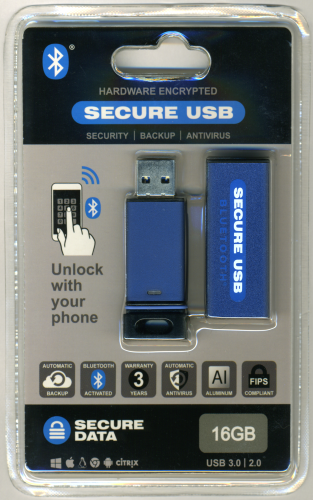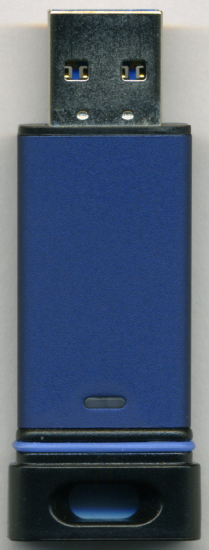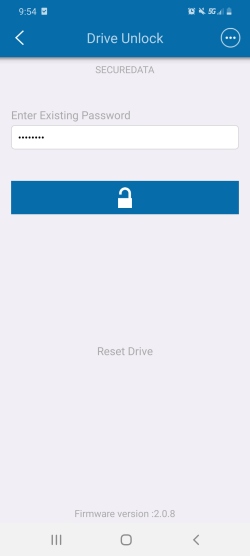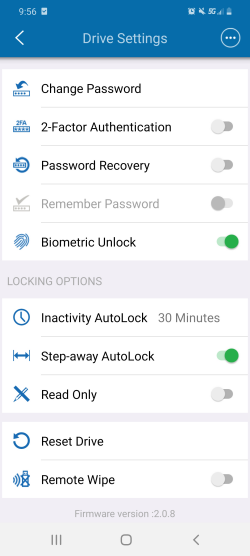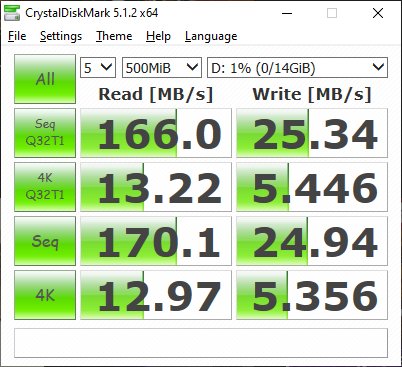

Model: SecureUSB BT Encrypted Flash Drive
Manufacturer: SecureData
Provided By: SecureData
SecureData is a worldwide leader in hardware encrypted storage and data services. Founded in California, USA in 2007, this privately held company pioneered many of the data recovery techniques currently used throughout the industry before expanding into e-discovery and forensics services. Today, the company offers a range of high-level data protection capabilities including hardware encrypted portable data storage devices, backup solutions, file repair software, data recovery and digital forensics services to help clients achieve their security objectives.
Over the last year or so, I've had the pleasure of reviewing SecureData's hardware encrypted SecureDrive BT portable SSD as well as their keypad-equipped SecureUSB KP flash drive. The company has now given me the opportunity to review its other encrypted flash drive, the SecureUSB BT. Available in capacities ranging from 4GB up to 128GB, this pocket-sized storage device features a FIPS compliant design with military-grade AES 256-bit XTS encryption. What really makes SecureDrive BT stand out amongst other encrypted USB flash drives is that, instead of a keypad, it offers secure wireless user authentication via the SecureData Lock app on your mobile device. The drive is also equipped with a rugged, extruded aluminum sleeve that protects it against dust, water and physical damage as well as a USB 3.0 interface capable of delivering up to 130 MB/s read and 43 MB/s write speeds.

With specs and features like this, it's hard not to be impressed by the SecureUSB BT. However, as you all know by now, we're not ones to take things at face value. In this review, we'll take a closer look at SecureData's encrypted USB flash drive and then put it through its paces to see how well it performs. Does the SecureUSB BT have what it takes? Keep reading as we find out.
The SecureUSB BT comes packaged in a plastic clamshell that gives you a clear view of the drive. The packaging also advertises many of the drive's key features including its 16GB capacity, automatic backup and antivirus, FIPS compliance, BlueTooth activation and 3 year warranty. Inside, you'll find the SecureUSB BT, a protective sleeve and a quick start guide.
Physical Features:
The SecureUSB BT measures 55 x 20 x 10 mm and tips the scales at 12g without the sleeve. This is a bit on the large side for a USB flash drive. However, its hardware encryption engine, physical protection mechanisms and BlueTooth module account for most of the extra bulk and weight.
While the ends of the SecureUSB BT are plastic, the body is constructed out of aluminum and is covered by a great looking blue finish. Above the opening at the bottom, there is also a small LED that shows the status of the drive. This indicator lights up red or blue and will blink to indicate whether the drive is locked, unlocked or transferring data.
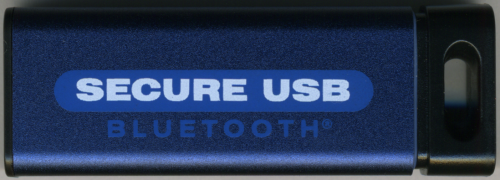
The SecureUSB BT comes with a rugged, extruded aluminum sleeve that protects the body of the drive from physical damage as well as dust and water to depths up to 1 meter.

The SecureUSB BT's internal components are protected by an epoxy compound so I wasn't able to crack it open. However, using Flash Drive Information Extractor, I could see that the drive uses Phison's PS2313 controller. Unfortunately, the app was not able to identify the memory chips being used.
One of the things that makes the SecureUSB BT unique is the ability to unlock your data from an iOS or Android device. Simply plug your drive into any computer with a USB port, fire up the app and connect to it via Bluetooth and unlock your data using the password that you set.
Setting up the SecureUSB BT is pretty straightforward. The first thing you'll want to do is install the SecureData Lock app which is available through Google Play and Apple App Store. Next, insert the SecureUSB BT into an available USB port on your computer. At this point, the drive will undergo a quick self-test where the LED blinks green, blue and then red. Once it's done, it will light up a solid red, indicating that it is locked but not connected to any devices.
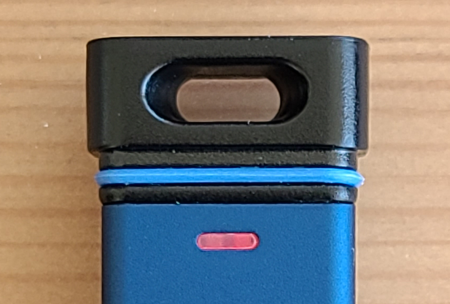
With the SecureUSB BT powered on, you can launch the SecureData Lock app on your mobile device. If this is the first time you've used it, you will need to pair the drive with the app by clicking on the "+" icon. The app will then use Bluetooth to try and find it. When it locates the drive, it will prompt you for the device ID that is printed right above the USB port.
Once the SecureUSB BT is paired with the SecureData Lock app, you can go ahead and unlock it. To do so, simply enter your password. If entered correctly, the lock icon in the app will turn green. The LED on the drive will also light up blue to show that it is unlocked and the data is accessible.
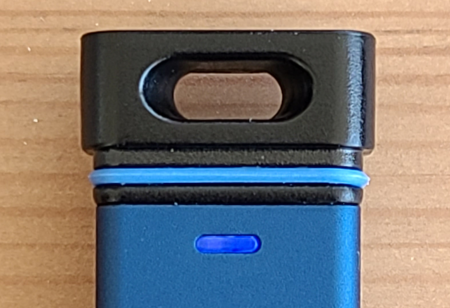
With the SecureUSB BT unlocked, you can use the SecureData Lock app to change the name of your drive as well as your password. You can also enable features like two-factor authentication and biometric unlock so that you can use facial recognition or your fingerprint instead of a password. It's also a good idea to enable the password recovery feature. Otherwise, if you forget your password, the drive will need to be reset and your data will be lost.
To keep people from guessing your password, the SecureUSB BT utilizes a brute force hack defense mechanism. If an incorrect password is entered 10 consecutive times, then the password and all data will be deleted. The SecureUSB BT will then need to be reformatted and a new password created before it can be reused.
The test system used in this review is equipped with an AMD Ryzen 3 3100 CPU, MSI B550 GAMING PLUS motherboard, 16GB (8GB x 2) of Crucial Ballistix 3200 MHz DDR4 memory, Crucial P5 1TB SSD and a GIGABYTE GeForce GTX 1060 WINDFORCE OC 6G graphics card. For the operating system, I used the latest version of Windows 10 Pro.
To test the performance of the SecureUSB BT flash drive, I ran a series of benchmarks using CrystalDiskMark, HD Tach RW and ATTO Disk Benchmark. To get a feel for the "real world" performance, I also copied and pasted 1GB of random files and directories as well as a single 4GB ISO file in Windows Explorer.
CrystalDiskMark 5.1.2:
First, I ran a few quick tests using CrystalDiskMark. This benchmark tool measures the performance of a storage device by testing its sequential read and write speeds as well as its random read and write speeds using blocks 512K and 4K in size.
According to SecureData, the SecureDrive BT is capable of reading at 130 MB/s and writing at 43 MB/s when connected to a USB 3.0 port. While the drive had no problems reaching its rated read speed, it came up short in CrystalDiskMark's sequential write speed test.
HD Tach RW 3.0.4.0:
Next, I used HD Tach to test the SecureUSB BT's read, write and burst speeds as well as its seek times and CPU usage.
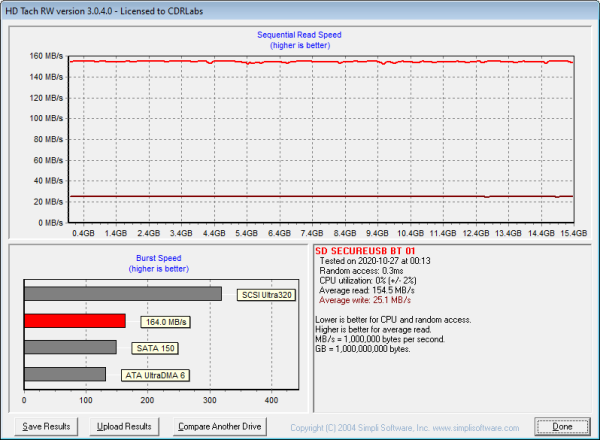
The performance here was very similar to what we saw with CrystalDiskMark. When connected to the computer's USB 3.0 port, the drive had average read and write speeds of 154.5 MB/s and 25.1 MB/s, respectively, as well as a burst speed of 164.0 MB/s.
ATTO Disk Benchmark 4.01:
I also used ATTO Disk Benchmark to test the SecureUSB KP's sequential read and write speeds. The tests are run using blocks ranging in size from 512B to 64 MB and the total length set to 256MB.
When tested with ATTO, the SecureUSB BT's read speeds topped out at about 163 MB/s and its write speeds at 24 MB/s.
"Real World" Benchmark:
To test the "real world" performance of the SecureUSB BT, I copied and pasted 1GB worth of randomly generated files and directories. All of the files are between 1KB and 95MB in size and no more than five directories deep. To see how well the drive handled large files, I also copied and pasted a 4GB ISO file.
| 1GB of Files | 4GB ISO File | |
| Write: | 46 seconds | 2:52 |
| Read: | 10 seconds | 26 seconds |
The SecureUSB BT performed fairly well here, taking 46 seconds to write 1GB worth of test data and 10 seconds to read it back.
Final Thoughts:
Like SecureData's other encrypted storage products, the SecureUSB BT is a great choice for the security conscious consumer or professional looking to keep sensitive data out of the wrong hands. Available in a number of different capacities, this USB flash drive features a FIPS compliant design, military grade full disk 256-bit AES hardware encryption and a rugged, extruded aluminum casing that protects it against dust, water and physical damage.
What really makes the SecureUSB BT stand out amongst other encrypted flash drives, though, is that it is unlocked via an app on your mobile device. This is not only easier to configure than a keypad, it offers additional features like two-factor authentication, password recovery and biometric unlock where you can use facial recognition or your fingerprint. Corporate IT departments can also enroll in a subscription that will allow them to remotely manage the SecureUSB BT and control things like where and when a drive can be unlocked.
When it comes to performance, the SecureUSB BT did relatively well in our tests. With all of the encryption being done at the hardware level, I found it to be just as fast as a non-encrypted USB 3.0 flash drive. Thanks to its USB 3.0 interface, the 16GB version of the SecureUSB BT was able to read at speeds as high as 166 MB/s and write at more than 25 MB/s.
The SecureUSB BT is available now in 16GB, 32GB and 64GB capacities and can be purchased directly from SecureData or through some of the sellers listed on Amazon.com. Prices currently range from $106 up to $169.

Highs:
- Secure wireless authentication via mobile device
- App features two factor authentication, password recovery and remote data wipe
- FIPS 140-2 Level 3 validated
- Military-grade AES 256-bit XTS hardware encryption
- Good read and write speeds
- Brute force anti-hacking self destruct feature
- Step-away autolock
- OS and platform independent
- Dust and water resistant
- Remote management ready
- USB 3.0 interface
- 3 year warranty
Lows:
- Slightly larger and heavier than non-encrypted flash drives
- Pricey
